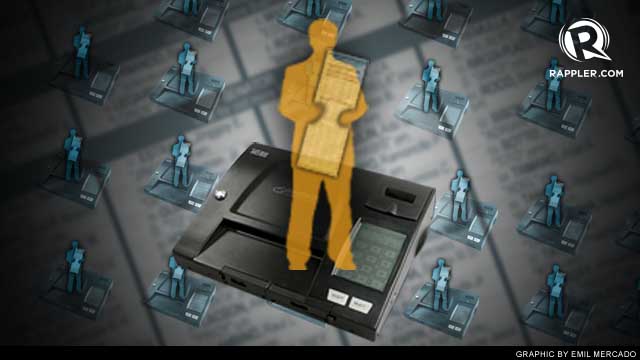SUMMARY
This is AI generated summarization, which may have errors. For context, always refer to the full article.

MANILA, Philippines – The mock elections triggered fears over the accuracy of ballot-counting machines after the discrepancies between the machine count and the manual audit exceeded the allowable limit.
How can the public trust the precinct count optical scan (PCOS) machines, which the Commission on Elections (Comelec) will use on May 13?
In a recent report obtained by Rappler, the official audit committee quelled these concerns, and attributed the discrepancies to human error. It showed the PCOS, at least in the sample precinct during the mock polls last February 2, was 100% reliable.
The Comelec en banc noted this report on April 19.
Required under the Automated Election System Law, the random manual audit (RMA) checks the accuracy of PCOS machines in selected precincts. The auditors do this by manually counting the votes and comparing these with the PCOS tally.
Speaking to reporters on Wednesday, May 1, Comelec chair Sixto Brillantes Jr said it is inevitable that the RMA will result in a number of discrepancies, due to “human appreciation.” “But the discrepancy should not be major – meaning, you will make mistakes, but just around one or two,” Brillantes said in a mix of English and Filipino. (Watch more in Rappler’s video report below.)
The law requires a 99.995% accuracy rating for the PCOS.
No food, water for auditors
What happened at the sample precinct, according to the RMA committee, was a mix of human factors and conditions that “were far from conducive.”
Done after the mock polls at the University of the Philippines Integrated School (UPIS), the audit yielded 15 discrepancies between the PCOS and manual counts. It breached the Comelec’s allowable margin of 10 votes per candidate per position, as stated in Comelec Resolution No. 9595, the general instructions for conducting the RMA.
The audit team found 13 discrepancies in votes for senators, and one each for votes for congressman and mayor
The human factors included lack of experience and failure to follow instructions, according to the memorandum by RMA committee member Ma Agnes Carreon to RMA committee chair Henrietta “Tita” de Villa. The memo read:
-
“Although the audit team was trained, the audit of the mock election results was their first or maiden hands-on experience with auditing automated election results.
-
“The audit team committed observable deviations from the general instructions. Ostensibly, the ‘check and balance’ mechanism between the manual count and verification groups was obviated.”
The unfavorable conditions included humidity and lack of food and water. The report said:
-
“The audit team arrived at around 4 o’ clock in the afternoon; however, the board of election inspectors finished their duties well past 10 o’ clock in the evening. On this note, the audit team was asked to stop after 3 o’ clock in the early morning.
-
“There was no provision for food and water for the audit team.
-
“The polling precinct was not sufficiently ventilated; thus, the said room became more humid as the number of observers increased.
-
“Members of the media and poll watchers from a citizens’ arm groups was hounding the audit team.”
A Comelec citizens’ arm, the National Citizens’ Movement for Free Elections (Namfrel), blasted the poll body over the RMA during the mock polls, as well as over other PCOS malfunctions.
“The malfunctioning of the PCOS machines will pose problems on congestion and long lines in the precincts, voluntary disenfranchisement for voters who do not have the time or patience to wait, possibility of low turnout, and frustration for both Board of Election Inspectors members and the voters,” Namfrel said in a letter to Brillantes.
‘Marked improvement’
Following the initial RMA, however, a new team re-audited the results “under controlled conditions.”
The new team did this in a well-ventilated office at midday, limited observers to the RMA committee, received provisions such as food and drinks, and didn’t work under time pressure.
The result of the new audit “was a marked improvement” from the one at UPIS, the RMA committee said.
The new audit team found zero discrepancies for votes for senators, congressman, and mayor. This was a seal of approval for PCOS machines – at least those used at UPIS last February 2.
In an earlier interview with reporters, Brillantes said the mock elections “was for our own assessment of the actual condition.” (View the slide show on the mock polls below.)
“Nakakita kami ng mga konting mali, kinorrect na namin lahat ‘yan. Kaya nga we did the mock elections months before (We saw a few glitches and we corrected them all. That’s why we did the mock elections months before.),” he explained.
Tougher challenge
RMA teams will face a tougher test, however, on May 13.
At the UPIS in February, the RMA team audited only 158 ballots. That was only 17.9% of the expected number of voters.
That wouldn’t be the case on election day, when 1,165 auditors will perform this double-checking process. (Read: More vote auditors to be assigned in 2013.)
For each of the country’s 233 districts, one team will do an RMA. The RMA committee will randomly choose the municipalities and the districts involved a few days before elections.
“Any difference between the automated and manual count will result in the determination of root cause and initiate a manual count for those precincts affected by the computer or procedural error,” the Automated Election Law or Republic Act No. 9369 states.
The RMA will test the accuracy of PCOS machines, this time on a national scale. – Rappler.com
Add a comment
How does this make you feel?
There are no comments yet. Add your comment to start the conversation.